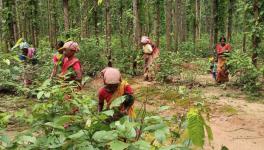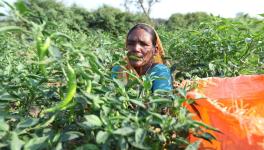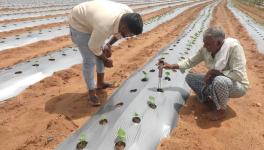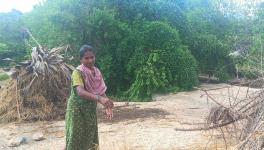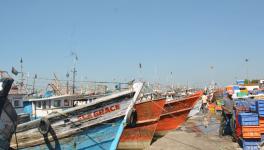Quarries in Bannerghatta Shut, but Their Ripples Still Felt on Forest Edge
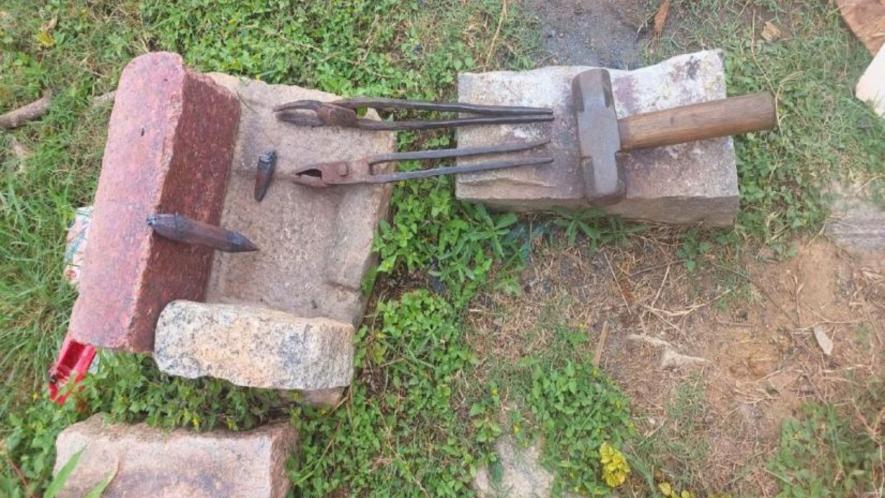
Bengaluru, Karnataka: On a cloudy July afternoon, Ratnamma* sits in front of her house narrating her days at one of the several quarries that functioned within the Bannerghatta National Park (BNP) near Bengaluru. Pointing away from her house, the woman in her late sixties said, "I worked for many years at the quarry over there. I was paid around Rs 150/day."
A 2016 draft notification from the Ministry of Environment, Forest and Climate Change (MoEFCC) had earmarked an Eco-sensitive Zone (ESZ) of 268.96 sq km in the BNP. Since then, multiple quarries have shut down, and they line the roads inside the park, under whose hilly terrains lie large reserves of granite.
Many of the former quarry workers live in 16 villages of Ragihalli panchayat. They have switched to similarly laborious jobs, such as farming and coolie work. They share common memories of loud crushers, earth-shaking blasts, dust swirls, and the ceaseless streams of lorries heading to the city. Many villagers lost their livestock to silica-laced dust that settled on the local flora, including ragi (finger millet) fields and the grass cows and goats eat.
Ratnamma belongs to a generation that has seen it all — the quiet peace of the forest and the rapid change when ambitious and well-off Bhovis in these 16 villages discovered its value.
"Before the 1980s, things were different here. Our people often entered the forest to gather wood and other materials for the households. Then a few people started businesses, and that grew to become a highly profitable industry," Raghava* (72) said.
For decades, those with a vested interest, business people and contract owners had been drawn to the abundant resources of the area. Within a few years, many granite quarries, residential layouts and bottling plants had emerged in and around the forest.
In many cases, the legality of such ventures was irrelevant to the men with money. Over time, that pervasive system reshaped the local political atmosphere, where dissenters were strong-armed into submission.
The quarries mainly relied on daily contract workers from the 16 villages and seasonal contract workers from Tamil Nadu. There was a clear division of labour between the two groups. While the villagers carried crushed stones to the trucks, the more strenuous task of breaking rocks was assigned to migrant labourers.
"The workers were primarily from the Bhovi community, traditionally known for their skills in stone art. Throughout history, the Bhovis worked as builders and sculptors. They worked on temple art and architecture, built wells, dams and water fountains and did other jobs that involve working with stones," Mukunda*, who works for the welfare of Bhovis, told 101Reporters.
According to The Wadar Community, a Denotified Tribe of Maharashtra in India: An Ethnographic Understanding, the word 'Bhovi' is a form of 'Bhavi', which means 'earth-digger' and 'well' in Kannada. The community originates in Odisha, from where they gradually migrated to southern states. Quarry owners preferred workers from the Bhovi community and justified their labour-intensive work as their caste-based occupation.
Skanda* expanded on this hiring trend: "Until the 1980s, the BNP land was used as commons, which all villagers utilised. This changed when some realised the land's value and took possession of the sites to set up quarries. Most of the quarry owners were local Bhovis. Over the decades, they gained upward mobility, enabling the next generation to look for jobs outside the quarry industry."
As a result, the mine owners began to employ Bhovis from Tamil Nadu, Kalaburagi and other parts of North Karnataka. The quarry owners and contractors regularly visited the villages in Tamil Nadu and recruited around 500 Bhovi families in one go. Lacking proper accommodation, these labourers lived in makeshift tents at the quarry sites themselves.
According to Bonded Labour in India: Its Incidence and Pattern, a report by Ravi S Srivastava, Director, Centre for Employment Studies, Institute for Human Development, New Delhi, the migrant labourers had taken paltry advances of Rs 500 to Rs 2,500 from the quarry owners. These advances came with a compound interest that the workers could not repay as they were only paid half the designated minimum wages.
Asked about the working conditions, Pilappa, a former quarry owner, said, "The Bhovi workers used their bare hands to smash rocks. They made other stone tools to break rocks into finer pieces. It was only around 15 to 20 years ago that machines like crushers were introduced in quarries." When the quarries shut, most migrant workers returned to Tamil Nadu, while some stayed back in search of other jobs.
The quarries have left a lasting impact on all areas of the ecosystem, including the Karadikkal-Madeswara elephant corridor located in the Harohalli Range. According to the Asian Elephant and Bannerghatta National Park in Eastern Ghats, Southern India, the corridor is about one km in length and 0.3 to 0.4 km in width, connecting the northern and southern portions of the park. Hundreds of elephants used to migrate to the wider Cauvery Wildlife Sanctuary in Karnataka and the Male Mahadeshwara Hills in Tamil Nadu through this corridor.
Activists, conservationists and NGOs have contested the size of the elephant corridor, as over 40% of the forest cover has been lost to encroachments within a few years. Moreover, the MoEFCC reduced the prescribed area of the ESZ in 2018, bringing it down to 168.84 sq km. The exclusion of several critical corridors thus endangered the wildlife.
Ramanan* (65), a former contract worker, recalled the mining hazards that made many relocate. "We stopped going near the forests. Rocks could fall on us any time," he told 101Reporters. The continuous blasts cracked their mud houses, whereas falling rocks reduced them to rubble in some cases.
Manjunath* (70) worked at these quarry sites for minimum wages. "For 15 years, I worked at different households for Rs 100 a year. When a household paid me at the beginning of the year, they did not allow me to work elsewhere. I stopped working there when I got married and took up quarry labour with my wife from then on," he said.
"The quarry trucks would take us to the site of that day's work. We would then carry the crushed stones in our baskets and load the truck. Once filled, the trucks would leave for the city. After work, I had to walk back to my village," he said. This extended his work hours far beyond the time he spent carrying gravel.
Like many in his generation, he moved from one exploitative job to another, leaving him with little time to tend to his health. Asked if the government helped him, he shook his head and said, "The villagers here are forgotten. When I am sick, I take one of the buses to the hospital in the city." Today, due to weakness in his limbs, Manjunath is entirely reliant on his wife for his day-to-day activities.
A case study assessing the health impact on quarry workers found that the mining projects in Ragihalli in the Bengaluru district have led to numerous skin and respiratory diseases. Although this report was put together when some quarries were operational, many villagers still suffer from these issues.
Ratnamma* suffers from persistent body aches. "I struggle to breathe while walking or working. Sometimes, I experience chest and back pains, making even sitting painful." This is a common complaint among the locals, to the extent that they cannot eat, drink or walk without help. "But I cannot afford to stop working. I need to pay debts," one of them remarked.
While mining projects affected everyone living within the ecosystem, the women labourers suffered the most. Bhagyamma,* now in her late 60s, recalled walking half a km to fetch water. "My job at the quarry required me to carry baskets of gravel on my head. After that, I had to walk a long distance to fetch water. I get headaches to this day as I carried water pots on my head then."
Women used to work during pregnancy and after childbirth. Bhagyamma used to carry her infants to the worksite. "As we could not leave them alone at home, we used to make a bed with a sheet placed on the ground before covering them with more sheets to prevent them from inhaling dust," she said.
While the land and its people are slowly healing from the damage caused by quarries in the BNP, a new challenge confronts the youth today. Many city dwellers have seized the opportunity to transform former quarry sites and pasture lands into resorts and retreat centres. Now, cars from the city zoom past the villages, changing the local dynamics yet again.
(Inchara S R and Aditi S are Karnataka-based freelance journalists and members of 101Reporters, a pan-India network of grassroots reporters.
Get the latest reports & analysis with people's perspective on Protests, movements & deep analytical videos, discussions of the current affairs in your Telegram app. Subscribe to NewsClick's Telegram channel & get Real-Time updates on stories, as they get published on our website.









